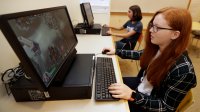Promoting a Sense of Community With Esports
An esports program with clubs, courses, and competitive teams can increase students’ feelings of belonging in the school community.
Your content has been saved!
Go to My Saved Content.Esports and digital gaming are very popular—there were 495 million viewers of esports worldwide in 2020, and 9.24 million active streamers on Twitch producing esports and gaming content, and a 2018 Pew survey found that 97 percent of teen boys and 83 percent of teen girls in the U.S. play video games. Schools that leverage this passion by setting up esports programs can potentially boost feelings of belonging for many students.
The best school programs include a combination of clubs, intramurals, competitive teams, and courses to provide access to the greatest number of students. When schools only establish competitive teams, they create barriers to participation—if a school of 1,000 students started two teams of 10 players, only 2 percent of students could participate. Including clubs and intramurals, as well as activities like video production and casting, is inviting to students who want to be part of esports but not play the games competitively.
The benefits are impactful in academic and social-emotional areas. Making positive connections through supportive relationships with students is important, and a study by the North American Scholastic Esports Federation found that students forged strong connections with peers and their school as a whole under the guidance of coaches and mentors.
Intentional planning is needed to create structures and practices for educating all students on good prosocial behaviors that preserve the fun and boost their feelings of belonging. Making a plan for teaching and coaching digital citizenship is critical to support students’ long-term growth in this area.
Intentional Planning for an Inclusive Esports Program
Step 1. Define what inclusiveness means to the program: Having worked with several esports planning teams, I’ve found this step to be crucial. Everyone has their own nuanced understanding of inclusiveness. Discussing those nuances leads to clarity and helps support the establishment of a common description for the term for your esports program. For me, inclusiveness is about everyone feeling welcome into the esports community, and that includes ensuring that every voice is being heard, considered, and respected.
It’s also important to distinguish equitable from equal experiences. Equal access can leave some students at a disadvantage if they’re starting out with less access to gaming. Equitable access helps close the gap between those with fewer resources and knowledge than others.
Two descriptions of equity and inclusiveness that I appreciate come from the University of Michigan and Ontario schools—these are good starting points for your discussion of these critical terms.
Step 2. Gather information about your students: Teachers and other adults should not assume that they know students’ perspectives about esports and gaming, even if they are gamers themselves. Use surveys and focus groups to get perspective from your students, ensuring that you include representation of all groups in your community. Explore questions about what students would like to see in an esports program that welcomes anyone to join, such as:
- What games do they play? Not all students are interested in playing the popular mainstream games. Some choices that you offer might be based on what colleges are playing. Other options should be included to bring in more students who may otherwise feel marginalized. Making sure a variety of games are available to students increases the potential of highlighting the wide-ranging interests of students with different backgrounds and communities.
- What challenges or problems do they find in gaming culture outside and inside of school? Bias and toxicity exist at varying levels inside each gaming community based on ethnicity, gender identity, and/or economic resources; for example, many males accept false stereotypes about females’ skills and attitudes toward gaming. Such attitudes can create a perception-based barrier for students who might want to participate in a school esports program. Intentionally addressing these concerns can go a long way to removing barriers, or perceptions of barriers, of bias or toxic attitudes so that all students feel welcome in the program.
Step 3. Develop guidelines for supporting inclusivity in the esports program: Guidelines serves as a reminder and review of expectations when planning each part of your program. For example, when recruiting for players, sports casters, and video production members, use the guidelines to ensure that marketing includes methods to get the largest and widest pool of candidates, one that represents the school population in all aspects from gender identity to ethnicity. Having clear guidelines can help reduce bias and ensure a thoughtful review where inclusivity is concretely reviewed before any final decision.
Monitoring and reviewing the guidelines should happen after each season or annually based on the students’ experience. Inclusivity is complex. There are always more layers to give attention to for further growth and development in expanding the community so that all students feel welcomed and have a voice.
